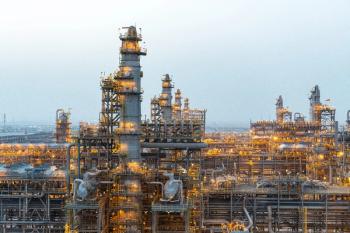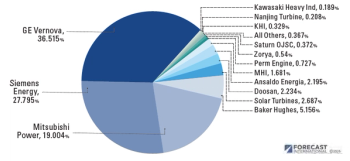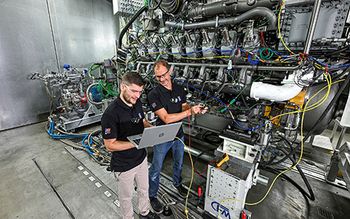
Turbo Expo Panelists Discuss Turbomachinery Strategies for a Clean-Energy Future
Flexibility and turbine advancements were the focal point of Wednesday’s panel.
During day three—Wednesday, June 26—of Turbo Expo 2024 in London, folks from academia, non-profit, government, and manufacturing gathered for the panel session Turbomachinery Solutions for Decentralized Energy Systems: Addressing Clean, Dispatchable, and Affordable Energy.
The panel—moderated by Giuseppe Tilocca, Scientific Officer, and Christer Björkqvist, Managing Director, at ETN Global—promoted interaction and discussion with stakeholders to highlight avenues to a sustainable energy future. By addressing how renewables are transforming the energy sector and how turbomachinery solutions offer flexibility and support a stable, reliable energy supply, the panel aimed to bridge the gap between current energy practices and climate targets.
The Role of Gas Turbines and Turbomachinery in Decentralized Energy Systems
The panel noted three major strategies that are addressing the challenges with current gas turbines and turbomachinery and a decrease in flexible capacity: fuel flexibility, digitalization, and efficiency improvements.
“Gas turbines and turbomachinery are evolving by pushing the boundaries of their inherent flexibility to provide mature and cost-effective solutions thereby ensuring a reliable and sustainable energy supply during the energy transition and beyond,” Tilocca said.
The flexibility requirements, as noted by organizations such as the Joint Research Center (JRC) and the Agency for the Cooperation of Energy Regulators (ACER), are expected to increase significantly; however, flexible capacity is decreasing. Effectively, Europe is projected to lose 107 GW of flexible capacity by 2030 (ENSTO-E). This decline is driven largely by the economic decommissioning.
To address these challenges, Tilocca noted several strategies that are being implemented:
- Fuel Flexibility: Gas turbines are being designed to operate on a variety of fuels, including hydrogen and biofuels, to ensure they can adapt to different energy sources.
- Digitalization: Advanced digital tools and analytics are being used to optimize operations and maintenance, allowing turbines to perform efficiently under varying conditions.
- Efficiency Improvements: Continuous advancements in turbine technology are improving the overall efficiency of these systems, reducing emissions, and lowering operating costs.
These measures are critical for ensuring that gas turbines remain a viable and sustainable option in a cleaner energy future. Moreover, Sean Fitzpatrick, CEO at Pure World Energy and operator of several microgrids, stressed the need to foster education and communication regarding the positive role of turbomachinery in the net-zero transition.
“Turbomachines are flexible solutions that by smart integration with renewables and storage systems will provide flexibility to decentralized systems also reducing the demand on national grids,” he said.
Combustion Systems
New combustion systems that enhance fuel flexibility are already available and being integrated into existing infrastructure. For example, Tilocca noted that the German Aerospace Center (DLR) has developed a retrofit system for 100 kWe turbine adapted to run entirely on hydrogen, based on technology from Ansaldo Green Tech. This turbine is ready for commercial deployment in Germany, indicating that the technology is already available.
The main gaps these technologies address include:
- Fuel Availability: While the technology to use diverse fuels exists, the supply chain for these fuels, particularly biofuels, is still developing.
- Investment Framework: There is a need for a supportive investment environment to fund the transition to these new technologies.
- Regulatory Support: Policies and regulations need to evolve to support the widespread adoption and the value chain development of sustainable fuels.
By filling these gaps, new combustion technologies help reduce reliance on fossil fuels, decrease emissions, and support the transition to a sustainable energy ecosystem.
How Gas Turbines Support Decentralized Power Generation
Clean and dispatchable technologies are the future, and gas turbines are an essential component for decentralized power generation. Tilocca said that decentralized generation involves producing electricity closer to where it is used, reducing transmission losses, and enhancing grid resilience.
The key roles of gas turbines in decentralized power generation include:
Providing Reliable Backup Power: Gas turbines can quickly ramp up production to meet demand during peak periods or when fluctuating renewable sources are insufficient.
Ensuring Grid Stability: Prof. David Sanchez from the Universidad de Sevilla said gas turbines help maintain grid balance and quality. “They can provide various grid response services, such as frequency regulation and voltage support,” he said.
Fitzpatrick also suggested that DSO (Distribution System Operator) in the United Kingdom is considering the inclusion of smaller distributed plants to provide grid services.
Supporting Renewable Integration: By complementing intermittent renewable energy sources like wind and solar, gas turbines help ensure a stable and reliable power supply.
These capabilities make gas turbines a critical component in the decentralized power generation mix, supporting a more resilient and flexible energy grid.
Market Requirements/Dynamics
Several market dynamics and operating conditions must be considered to transform current energy practices and support a cleaner energy future.
- Affordability: Fitzpatrick pointed out that customers are keen to decarbonize but struggle with the high costs of clean, dispatchable solutions. Affordability is a major barrier, as high costs can drive businesses out of the market.
- Market Uncertainty: The energy market is undergoing rapid changes to ensure fairness and sustainability in a landscape incorporating not only dispatchable and non-dispatchable renewable energy technologies but also different energy-storage technologies with evolving requirements and significant uncertainty. Companies must be agile and adaptable to keep up with these shifts.
- Reduced Operating Hours: Dang Le, Program Manager - Government and University Research at Solar Turbines, said there is a trend toward fewer operating hours for gas turbines—from 8,000 hours per year to around 1,000–and moving from 2/3 shutdowns per year to per day. This comes with the requirement from customers for more flexible operations such as part-load conditions and faster ramp rates. This increased operational stress can affect engine life and maintenance schedules, which must be considered in the design phase and throughout the equipment's lifetime.
To navigate these challenges, it is essential to develop cost-effective, adaptable solutions that can meet evolving market demands while supporting the transition to a sustainable and clean energy future.
Newsletter
Power your knowledge with the latest in turbine technology, engineering advances, and energy solutions—subscribe to Turbomachinery International today.





